![]()
![]()
![]()
Use LEFT and RIGHT arrow keys to navigate between flashcards;
Use UP and DOWN arrow keys to flip the card;
H to show hint;
A reads text to speech;
51 Cards in this Set
- Front
- Back
- 3rd side (hint)
|
Harmful effect of ionising radiation |
1) large foes over short period of time: radiation burns on the skin and radiation poisoning, due to cell damage. 2) small does over a long period of time: DNA damage, called mutation. The mutated cells can cause a cancer (rapid uncontrolled division. Risks come from working with radioactive sources, eg in industrial or medical uses or from contamination after nuclear substance. |
|
|
|
Rutherfords results |
The particles that went straight through passed through the empty space between the nucleus and the electrons in the atoms The particles that were deflected by small angles passed close to the positively charged nucleus The particles that were deflected by large angles hit the dense, positively charged nucleus |
|
|
|
Mass and charge of proton |
Mass = 1 Charge = +1 |
|
|
|
Mass and charge of neutron |
Mass = 1 Charge = 0 |
|
|
|
Mass and charge of electron |
Mass= 1/1840 Charge = -1 |
|
|
|
Average nucleus radius |
10 -15 m |
|
|
|
Average atom radius |
10 -10 m |
|
|
|
What is an isotope |
An isotope has the same number of protons but different number of neutrons This means isotopes have same charge but different mass |
|
|
|
What did Bohr work out? |
He worked out that electrons occupied energy levels Inner shell = low energy Outer shell = high energy When an atom gets energy, and electron (normally on the outer shell) goes up to a higher energy level When an electron falls back down, it gives off energy as an electromagnetic wave——> a big drop produces a high energy wave with short wave length (eg uv) a small drop produces a low energy wave with large wave length (eg visible or infrared) |
|
|
|
What is ionising radiation |
If an atom is an UNSTABLE ISOTOPE it can change the makeup of its nucleus releasing IONISING RADIATION IONISING RADIATION is radiation that has enough energy to knock electrons out of atoms to.turn them into ions |
|
|
|
What is radioactivity |
Radioactive atoms have unstable nuclei. The nucleus decays to become stable by losing energy when certain types of radiation is emitted from the nucleus. These types are alpha beta and gamma. You cannot predict when a nucleus will decay as it is a random process. |
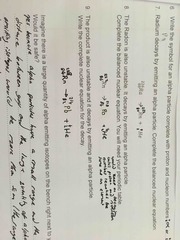
|
|
|
Ways to measure radioactivity: spark counter |
Spark counter consists of a thin metal mesh connected between positive and negative electrodes of a kilovolt supply When ionising radiation passes between a gap in the mesh it may ionising the air This causes a flow of charge between the electrodes (a spark) |
|
|
|
Ways to measure radioactivity: GM tube |
Contains of an anode in the middle of a cylindrical cathode with air between them The speaks are detected by a digital counter allowing measurement of total number of sparks per minute The activity of a radioactive substance is measure in Bq or becquerels When testing source, it is important to take an average reading of the background radiation so it can be subtracted from and subsequent readings |
|
|
|
Alpha radiat |
It is a helium nucleus with 2 protons and 2 neutrons Relative mass of 4 Relative charge of 2+ Is the strongest ioniser A thin sheet of paper can stop it It’s range in air is a few cm |
|
|
|
Alpha radiation |
It is a helium nucleus with 2 protons and 2 neutrons Relative mass of 4 Relative charge of 2+ Is the strongest ioniser A thin sheet of paper can stop it It’s range in air is a few cm |
|
|
|
Beta radiation |
Is a fast moving electron Relative mass of 1/1840 Relative charge of -1 Ionising potential is less than alpha 3mm of aluminium can stop it Has a range of a few metres is air |
|
|
|
Gamma radiation |
Is a high frequency EM rave Relative mass of 0 Relative charge of 0 Has a weak ionising potential (10x less than beta A few cm of lead can stop it Has a range of a few Km in air |
|
|
|
What is background radiation and why is it important? |
Is the radiation that naturally exists in our environment. Must measure it before examining ressources so you can subtract from your results to make the results more accurate. |
|
|
|
Where does background radiation come from? |
49% from radon gas sources underground 15% from medical sources 13% from building materials that may contain radioactive compounds 12% from outer space 10% from food and drink Less than 1% from nuclear industry |
|
|
|
Alpha particle decay |
Mass number decreases by 4 and atomic number decrease by 2, the decayed atom has changed into a new element |
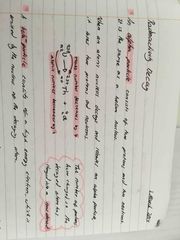
|
|
|
Beta - particle decay |
Mass number remains the same, atomic number increases by 1 Has changed into new element |
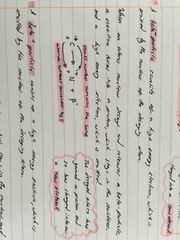
|
|
|
Beta + particle decay |
Mass number stays the same, atomic number decreases by 1 Changes into a new element |
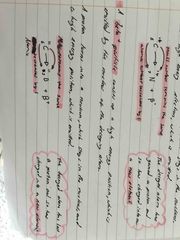
|
|
|
Gamma radiation decay |
Mass number stays the same, atomic number stays the same Does not change into a new particle |
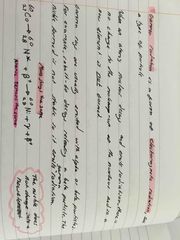
|
|
|
Neutrons |
Neutrons have no charge so they don’t interact with matter like alpha and beta particles. Neutrons travelling at a high speed can penetrate materials like gamma radiation Materials subjected to neutron radiation can absorb a neutron and may become radiation |
|
|
|
Harmful effect of ionising radiation |
1) large foes over short period of time: radiation burns on the skin and radiation poisoning, due to cell damage. 2) small does over a long period of time: DNA damage, called mutation. The mutated cells can cause a cancer (rapid uncontrolled division. Risks come from working with radioactive sources, eg in industrial or medical uses or from contamination after nuclear substance. |
|
|
|
What is a chain reaction |
One neutron produces fission. The neutrons produced produce 1 or more extra fission and so on. |
|
|
|
What is a controlled reaction? |
On average, one fission produce another fission. Other neutrons are absorbed by control rods. This happens at a nuclear power station and will last for about 6 years until most uranium is fissioned |
|
|
|
What is an uncontrolled reaction? |
Every neutron goes into another fission so the rate of reaction increases exponentially. This happens in a nuclear weapon and the whole lot fissions in a millionth of a second. |
|
|
|
Parts and jobs of a nuclear reactor |
MODERATOR: This slow the neutrons down so they can cause fissions. Often water or graphite. CONTROL RODS: Boron steel, these absorb neutrons so they cannot cause fissions. FUEL: Rods is U-235. Spent fuel consists of radioactive daughter nuclei (nuclear waste). COOLANT: Takes the heat away from the core to be used. Water or pressurised CO2. HEAT EXCHANGER: Transfer heat to the second water loop to make steam. |
|
|
|
How to do nuclear fusion on earth |
In a tokamak- a doughnut shaped ring of magnets that hold hydrogen under pressure without touching the sides, or a high intensity laser mounting at a very small palet if fuel. The raw material used in a tokamak is deuterium (from water) and tritium (from lithium). The waste product is helium, this is good as there are no carbon emissions |
|
|
|
What are the drawbacks of fission? |
Reaction is radioactive Reaction produces less energy than fission Uncontrollable without control rods Uranium is finite |
|
|
|
How PET scanners work |
In a PET scanner a positron emitter produced by a cyclotron is injected into the bloodstream where it accumulates in various tissues and organs of the body. As the particle passes through the tissue it meets and electron and annihilation takes place to produce a gamma ray pair. Sensors placed around the patient detect the gamma ray pairs produced. Through computer analysis they are able to build up an images of the internal organs under examination |
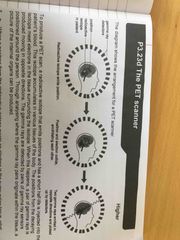
|
|
|
How industrial risks are minimised |
-not pointing sources at people - using tongs to increase distance from source -shielding the source with lead or leaded glass -staff wearing a dosimeter (a badge to monitor the does over time -using short half lives in medical uses |
|
|
|
What is the most dangerous type or radiation |
Depends on half life, amount, wether inside or outside body (alpha is most dangerous inside body, gamma is most dangerous outside due to relative penetrating power. |
|
|
|
Radiation in detecting a leak from a pipe |
Type: gamma Why: only type that can penetrate thick soil Half life: hours Why: long enough to be detected but does not stay in environment for years How it works: radiation put in water, water leaks and the large quantity is detected |
|
|
|
Radiation in monitoring the thickness of foil |
Type: beta Why: alpha wouldn’t go through, all of gamma would go through Half life: years Why: needs to last long as changing it is expensive How it works: beta is sent through, if to much gets through rollers will widen vice versa |
|
|
|
Parts and jobs of a nuclear reactor |
MODERATOR: This slow the neutrons down so they can cause fissions. Often water or graphite. CONTROL RODS: Boron steel, these absorb neutrons so they cannot cause fissions. FUEL: Rods is U-235. Spent fuel consists of radioactive daughter nuclei (nuclear waste). COOLANT: Takes the heat away from the core to be used. Water or pressurised CO2. HEAT EXCHANGER: Transfer heat to the second water loop to make steam. |
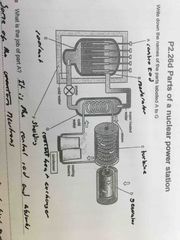
|
|
|
What happens in a nuclear fusion reactor |
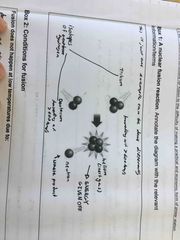
Back (Definition) |
|
|
|
Radiation in medical radiotracer |
Type: gamma Why: must be able to penetrate body and be detect Half life: hours Why: long enough to be detected but mustn’t be in body for too long How it works: gamma rays enter body and are absorbed by thing that needs detecting |
|
|
|
How PET scanners work |
In a PET scanner a positron emitter produces by a cyclotron is injected into the bloodstream where it accumulates in various tissues and organs of the body. As the particle passes through the tissue it meets and electron and annihilation takes place to produce a gamma ray pair. Sensors placed around the patient detect the gamma ray pairs produced. Through computer analysis they are able to build up an images of the internal organs under examination |
|
|
|
Name and explain 2 types of reactions that deliver vast amounts of energy |
Nuclear fission: a slow moving neutron collided with the nucleus of uranium-235. The nucleus splits into 2 daughter nucleu and 2 or 3 fast moving neutrons. Lots of energy is given off (the energy is mainly the kinetic energy of neutrons). Nuclear fusion: 2 smaller nuclei join (fuse) together to make a larger nucleus. This explains how the sun shines and may produce power on earth in the future. |
|
|
|
Parts of the solar system |
PLANETS: orbit a star (eg sun) DWARF PLANETS: orbit a star but are too small to be a planet MOONS: orbit planets with circular orbit, are natural satellite ARTIFICIAL SATELLITES: issuable orbit earth in fairly circular orbit ASTEROIDS: lumps of rock and metals that orbit the sun. COMETS: lumps of ice and dust that orbit the sun. Orbits are usually highly elliptical. |
|
|
|
Parts of the solar system |
PLANETS: orbit a star (eg sun) DWARF PLANETS: orbit a star but are too small to be a planet MOONS: orbit planets with circular orbit, are natural satellite ARTIFICIAL SATELLITES: issuable orbit earth in fairly circular orbit ASTEROIDS: lumps of rock and metals that orbit the sun. COMETS: lumps of ice and dust that orbit the sun. Orbits are usually highly elliptical. |
|
|
|
Gravity and it’s affects on orbits |
In a circular orbit, an object travelling at a constant speed is constantly accelerating. The force causing this is the centripetal force as it acts towards the centre of the circle. This forces would cause the object to fall towards whatever it was orbiting but as the object is already moving it just causes it to change direction, so the object keeps accelerating towards the object it is orbiting, but the instantaneous velocity (which is at a tight angle to the acceleration) keeps it travelling in a circle. Gravitational field strength depends on the mass of the body creating the field. The larger the mass of the body, the stronger its gravitational field. Gravitational field strength also varies with distance, the closer the stronger. The stronger he force lease to a larger instantaneous velocity needed to balance it. So the closer to a start or planet you get, the faster you need to go to remain in orbit. For an overheat in a stable orbit, if the speed of the object changes, the size of its radius must do so too. Faster moving objects will move in a stable orbit with a smaller radius than slower moving ones. |
|
|
|
Gravity and it’s affects on orbits |
In a circular orbit, an object travelling at a constant speed is constantly accelerating. The force causing this is the centripetal force as it acts towards the centre of the circle. This forces would cause the object to fall towards whatever it was orbiting but as the object is already moving it just causes it to change direction, so the object keeps accelerating towards the object it is orbiting, but the instantaneous velocity (which is at a tight angle to the acceleration) keeps it travelling in a circle. Gravitational field strength depends on the mass of the body creating the field. The larger the mass of the body, the stronger its gravitational field. Gravitational field strength also varies with distance, the closer the stronger. The stronger he force lease to a larger instantaneous velocity needed to balance it. So the closer to a start or planet you get, the faster you need to go to remain in orbit. For an overheat in a stable orbit, if the speed of the object changes, the size of its radius must do so too. Faster moving objects will move in a stable orbit with a smaller radius than slower moving ones. |
|
|
|
Models of the universe |
GEOCENTRIC MODEL- suggests that the sun, moon, stars and planets all orbit the earth in perfect circles HELIOCENTRIC MODEL- earth and all planets orbited the sun in circular orbits, evidence: Jupiter and its moons by Galileo CURRENT MODEL- same as heliocentric model but things move in elliptical orbits rather than circular. |
|
|
|
Models of the universe |
GEOCENTRIC MODEL- suggests that the sun, moon, stars and planets all orbit the earth in perfect circles HELIOCENTRIC MODEL- earth and all planets orbited the sun in circular orbits, evidence: Jupiter and its moons by Galileo CURRENT MODEL- same as heliocentric model but things move in elliptical orbits rather than circular. |
|
|
|
Theories for creation of the universe |
STEADY STATE: univers has always existed and always will do, as the universe expands, new matter is constantly being created. This means that the density of the universe will roughly be the same. BIG BAND THEORY: initially all matter occupied small space. This isn’t space was very dense so very hot. Then it ‘exploded’ - space started expanding and is still expanding. Accepted theory due to red shift. |
|
|
|
Red-shift and CMB radiation |
When elements absorb different frequencies of light, they produce a pattern of dark lines at the frequencies absorb visible light. When we look at light from distant galaxies we see the same patterns but at slightly lower frequencies. There is an absorbed increase in the wavelength of light coming from the galaxies and the patterns have been shifted towards the red end of the spectrum called red-shift. Measurements of red-shift suggest that all the distant galaxies are moving away from us. More distant galaxies have greater red-shifts so more distant galaxies are moving away faster and thus the universe is expanding. CMB (cosmic microwave background radiation) comes from all parts of the universe. Redshift can be explained by both steady state and Big Bang. In both models objects are moving away. However CMB radiation only supports big band as it shows the universe had a beginning. |
|
|
|
Life cycles of a star |
1) NEBULA- initially form from a cloud of dust and gas 2) PROTOSTAR- Gravity pulls the dust and gas together to form a protostar. Temperature rises as the star gets denser and more particles collide with each other. When temperature gets Hogg enough nuclear fusion happens to form helium nuclei. 3) MAIN SEQUENCE STAR- star enter a long stable period. During this period, the outward pressure is caused by thermal expansion, balances with gravity pulling everything inwards. 4) a) if the star is much bigger than the sun: RED SUPERGIANT b) if the star is the same size as the sun: RED GIANT) hydrogen in the core runs out and the force of gravity is larger than pressure of thermal expansion. The star is compressed until it is dense and hot enough that the energy created makes the outer layers of the star expand. It becomes red because the surface cools. 5) b) WHITE DWARF- becomes unstable and ejects outer layers of dust and gas. Leaves behind a hot, dense solid core- a white dwarf. 5) a) SUPERNOVA- big stars start to glow brightly again as they undergo more fusion to make heavier elements. They expand and contract several times, as the balance shifts between gravity and thermal expansion. Eventually they explode in a supernova. 6) a) NEUTRON STAR/BLACK HOLE- the exploding supernova throws the outer layers of dust and gas into space, leaving a very dense core called a neutron star. If the star is big enough, it will collapse and become a back hole- a super dense point in space that not even light can escape from. |
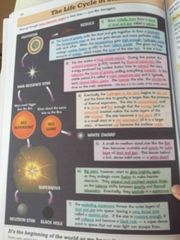
|
|
|
Looking into space |
To increase quality of image through telescope: 1) increase the aperture of the telescope 2) use a higher quality objective lens Light from earths atmosphere makes observing light frequencies hard, so one must place telescope on top of mountain (where there’s less atmosphere above it) or in a dark place away from cities. Or one could places telescope in space to avoid problem of atmosphere completely. |
|

